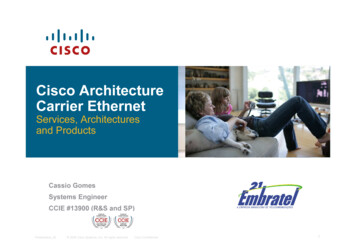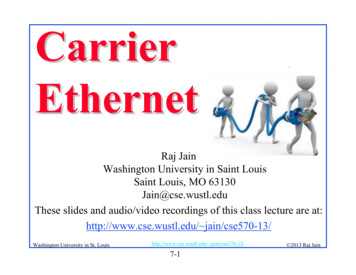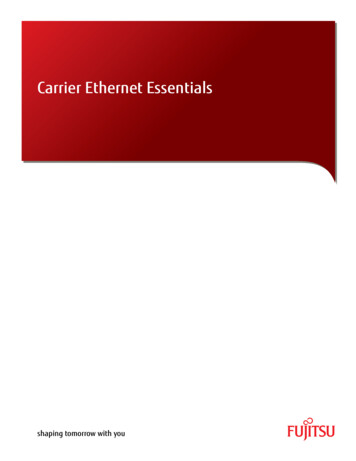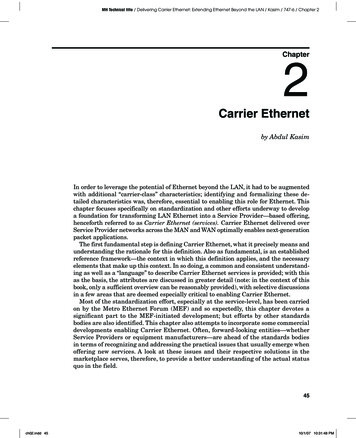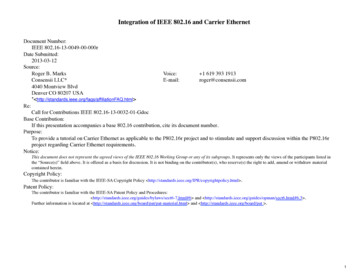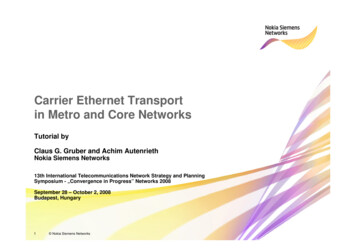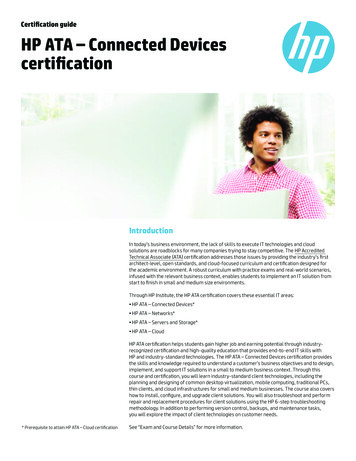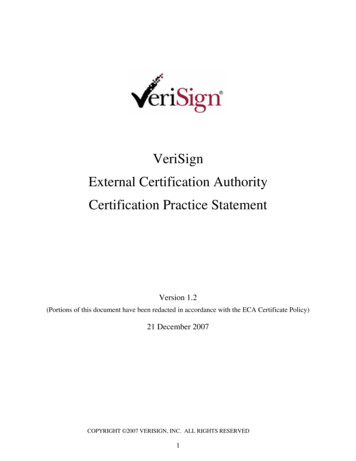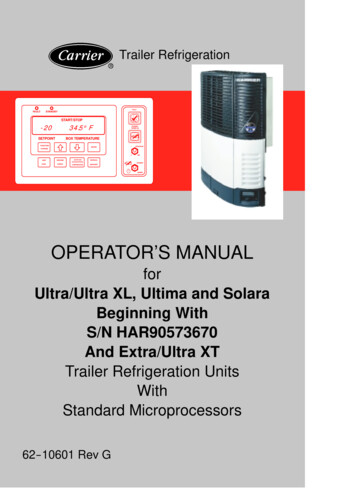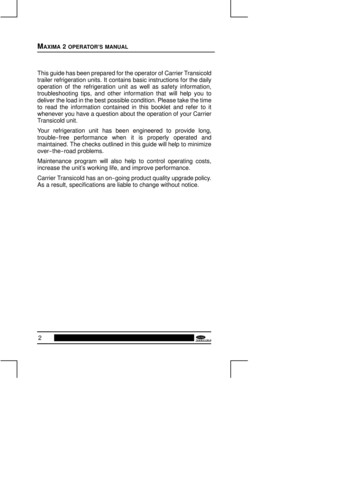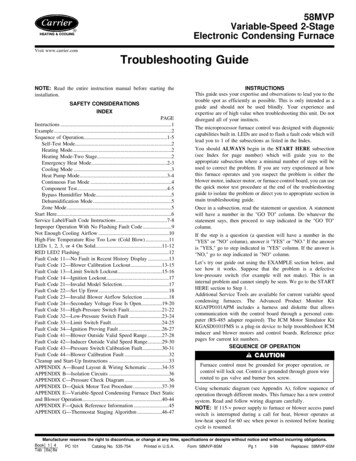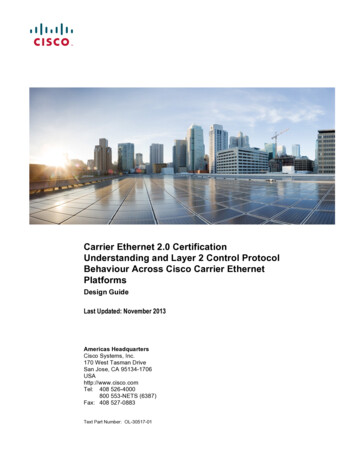
Transcription
Carrier Ethernet 2.0 CertificationUnderstanding and Layer 2 Control ProtocolBehaviour Across Cisco Carrier EthernetPlatformsDesign GuideLast Updated: November 2013Americas HeadquartersCisco Systems, Inc.170 West Tasman DriveSan Jose, CA 95134-1706USAhttp://www.cisco.comTel: 408 526-4000800 553-NETS (6387)Fax: 408 527-0883Text Part Number: OL-30517-01
THE SPECIFICATIONS AND INFORMATION REGARDING THE PRODUCTS IN THIS MANUAL ARE SUBJECT TO CHANGE WITHOUT NOTICE. ALLSTATEMENTS, INFORMATION, AND RECOMMENDATIONS IN THIS MANUAL ARE BELIEVED TO BE ACCURATE BUT ARE PRESENTED WITHOUTWARRANTY OF ANY KIND, EXPRESS OR IMPLIED. USERS MUST TAKE FULL RESPONSIBILITY FOR THEIR APPLICATION OF ANY PRODUCTS.THE SOFTWARE LICENSE AND LIMITED WARRANTY FOR THE ACCOMPANYING PRODUCT ARE SET FORTH IN THE INFORMATION PACKET THAT SHIPPEDWITH THE PRODUCT AND ARE INCORPORATED HEREIN BY THIS REFERENCE. IF YOU ARE UNABLE TO LOCATE THE SOFTWARE LICENSE OR LIMITEDWARRANTY, CONTACT YOUR CISCO REPRESENTATIVE FOR A COPY.The Cisco implementation of TCP header compression is an adaptation of a program developed by the University of California, Berkeley (UCB) as part of UCB’s public domainversion of the UNIX operating system. All rights reserved. Copyright 1981, Regents of the University of California.NOTWITHSTANDING ANY OTHER WARRANTY HEREIN, ALL DOCUMENT FILES AND SOFTWARE OF THESE SUPPLIERS ARE PROVIDED “AS IS” WITH ALLFAULTS. CISCO AND THE ABOVE-NAMED SUPPLIERS DISCLAIM ALL WARRANTIES, EXPRESSED OR IMPLIED, INCLUDING, WITHOUT LIMITATION, THOSEOF MERCHANTABILITY, FITNESS FOR A PARTICULAR PURPOSE AND NONINFRINGEMENT OR ARISING FROM A COURSE OF DEALING, USAGE, OR TRADEPRACTICE.IN NO EVENT SHALL CISCO OR ITS SUPPLIERS BE LIABLE FOR ANY INDIRECT, SPECIAL, CONSEQUENTIAL, OR INCIDENTAL DAMAGES, INCLUDING,WITHOUT LIMITATION, LOST PROFITS OR LOSS OR DAMAGE TO DATA ARISING OUT OF THE USE OR INABILITY TO USE THIS MANUAL, EVEN IF CISCO ORITS SUPPLIERS HAVE BEEN ADVISED OF THE POSSIBILITY OF SUCH DAMAGES.Cisco and the Cisco Logo are trademarks of Cisco Systems, Inc. and/or its affiliates in the U.S. and other countries. A listing of Cisco's trademarks can be found atwww.cisco.com/go/trademarks. Third party trademarks mentioned are the property of their respective owners. The use of the word partner does not imply a partnership relationshipbetween Cisco and any other company.Any Internet Protocol (IP) addresses and phone numbers used in this document are not intended to be actual addresses and phone numbers. Any examples, command displayoutput, network topology diagrams, and other figures included in the document are shown for illustrative purposes only. Any use of actual IP addresses or phone numbers inillustrative content is unintentional and coincidental.Cisco ME3600X-24TS/ME3600-24CX/ME3800X Design Guide 2013 Cisco Systems, Inc. All rights reserved.
CONTENTSContents . iiiPreface . ivIntroduction . ivChapter 1Carrier Ethernet (CE) 2.0 Certification . 5What is Carrier Ethernet (CE) 2.0 certification ? . 5What is new in Carrier Ethernet 2.0 certification ? . 5CE 2.0 Services . 6CE2.0 Features . 7CE 2.0 Test Cases Scope . 8How is the CE 2.0 hardware platform certification done ? . 9Chapter 2CE 2.0 L2 Control Protocol (L2CP) Forwarding . 11CE 2.0 L2 Control Protocol (L2CP) Forwarding requirements for different Services . 11CE 2.0 L2 Protocol Forwarding across Platforms . 13Cisco 7600 - CE 2.0 L2 Protocol Forwarding configurations . 14Cisco ME3600X/3800X/3600X-24CX and Cisco ASR 903 - CE 2.0 L2 Protocol Forwarding configurationsCisco ASR 9000 - CE 2.0 L2 Protocol Forwarding configurations . 2018Chapter 3CE 2.0 E-Access . 23Cisco Template OL-30517-01iii
ContentsPrefaceIntroductionThe document outlines the fundamental understanding of Carrier Ethernet 2.0 certification and also outlinesthe L2 protcol forwarding behaviour differences between Cisco Carrier Ethernet platforms withconfiguration examples.iv
Chapter 1 Carrier Ethernet (CE) 2.0 CertificationWhat is Carrier Ethernet (CE) 2.0 certification ?Introduced by Metro Ethernet Forun (MEF)Standardizes classes of service, performance tiers and objectives, service and traffic management as well asinterconnected access services, the MEF is creating the most efficient path possible for the Carrier Ethernetindustry to build products and deploy services that drive its expansion in the global telecommunicationsmarketplace.And by introducing Carrier Ethernet (CE) 2.0 certification for services and equipment, the MEF is alsocreating the most efficient path possible for the Carrier Ethernet community to align new products and newservices to the higher standards of Carrier Ethernet.What is new in Carrier Ethernet 2.0 certification ?SERVICES - CE2.0 standardizes new services like E-Tree and E-Access, along with E-Line and E-LANservices that were defined in CE1.0FEATURES - CE 2.0 Standardizes and certifies three powerful services features: Multi-CoS,Manageability and Interconnect.Cisco Template OL-30517-015
CE 1.0CE 2.0Certifying first generation of standardizedservicesCertifying next generation of standardizedfeatures & servicesService StandardizationMulti-CoSManageabilityE-Line(EPL, EVPL)E-Line(EPL, EVPL)E-LANE-LAN(EP-LAN, EVP-LAN)InterconnectE-Tree(EP-Tree, EVP-Tree)E-Access(Access EPL, Access EVPL)Based on MEF Technical SpecificationsMEF 6.1, MEF 10.2, MEF 23.1, MEF 26.1,MEF 33Based on MEF Technical SpecificationsMEF 6, MEF 10CE 2.0 ServicesEach Service types can be further classified into : Port Based Service – EPL, EPLAN, EP-Tree VLAN based service - EVPL, EVPLAN, EVP-TreeService TypePort Based ServiceVLAN Based ServiceE-LineEPLEthernet Private LineEVPLEthernet Virtual Private LineEP-LANEthernet Private LANEVP-LANEthernet Virtual Private LANPoint-to-point EVCUNI to UNIE-LANMultipoint-to-multipoint EVCUNI to UNI
E-TreeRooted-multipoint EVCUNI to UNIE-AccessPoint-to-point OVCUNI to ENNIEP-TreeEthernet Private TreeEVP-TreeEthernet Virtual Private TreeAccess EPLAccess Ethernet Private LineAccess EVPLAccess Ethernet Virtual Private LineCE 2.0 FeaturesMulti-CoSManageabilityØ END-TO-END FAULTØ MULTIPLE CLASSES OF SERVICE MANAGEMENTØ STANDARDIZED PERFORMANCE Ø STANDARDIZEDOBJECTIVESGRANULARITIES FOR TRAFFICMANAGEMENTStandardized CoS Labels High Medium LowStandardized Color Identifiers S-Tag PCP bits without DEI support S-Tag PCP bits with DEI support C-Tag PCP bits DSCPStandardized Performance Tiers PT1 - Metro PT2 - Regional PT3 - Continental PT4 - GlobalStandardized Performance Metrics &Objectives Frame Delay FD Mean Frame Delay MFD Inter-Frame Delay Variation IFDV Frame Delay Range FDR Frame Loss Ratio FLRService OAM Subscriber and Test MEGs Continuity Check - CCM Linktrace - LTM & LTR Loopback - LBM & LBRBWP Granularity UNI to UNI Up to 10M in steps of 1M From 10M to 100Ms in steps of 5M From 100M to 1G in steps of 50M From 1G to 10G in steps of 500MBWP Granularity UNI to ENNI Up to 10M in steps of 1M From 10M to 100Ms in steps of10M From 100M to 1G in steps of 100M From 1G to 10G in steps of 1GMaximum Transmission Unit UNI MTU, EVC MTU ENNI MTU, OVC MTUL2CP Handling Must Tunnel Must Not TunnelInterconnectØ STANDARDIZED WHOLESALEINTERCONNECT SERVICEØ EXTENDS SERVICESCOVERAGEUNI to ENNI Services Access EPL Access EVPLStandardized ENNI ENNI Frame format – 802.1ad-2005 Single tagging option - S-tag Double tagging option - C-Tag STag ENNI MTU Size 1526 Bytes ENNI End Point mapStandardized OVC End Points Color-Aware BWP at ENNI CoS ID for ENNI Frames Color-Blind BWP at UNI CoS ID for Service Frames OVC End Point MapsStandardized OVC Point-to-Point OVC Color Forwarding Yes CE-VLAN ID & CoS Preservation Service Level Specification
CE 2.0 Test Cases ScopeThe tests carried out for CE2.0 certification are mentioned below, the tests vary from basic physicalinterface tests, Layer 2 Control Protocol handling, Performance to QoS.Test Cases for Physical Interface & Frame Format Physical Medium, Speed, Mode and MAC La Untagged, C-tagged, S-tagged frames – 802.1ad-2005Test Cases for UNI Attributes UNI Service Multiplexing UNI Bundling UNI All-to-One Bundling Maximum number of CE-VLAN ID per OVCTest Cases for EVC and OVC Support Point-to-point EVC and Point-to-point OVC Multipoint-to-multipoint EVC and Rooted-multipoint EVC CE-VLAN ID and CE-VLAN CoS Preservation CE-VLAN ID/EVC Map and OVC EP Map Unicast, Multicast, Broadcast Service Frame DeliveryTest Cases for L2CP Handling L2CP Must Tunnel L2CP Must Not TunnelTest Cases for Service OAM Handling Subscriber MEG and Test MEG CCM, LBM, LBR, LTM and LTR messagesTest Cases for Performance One-Way Frame Delay Performance One-Way Mean Frame Delay Performance One-Way Inter-Frame Delay Performance One-Way Frame Delay Range One-Way Frame Loss RatioTest Cases for Ingress Bandwidth Profile CIR Enforcement CBS Enforcement EIR Enforcement EBS Enforcement
Bandwidth Profile GranularityPer UNI bandwidth profilePer EVC bandwidth profilePer Class of Service (PCP, DSCP, L2CP) bandwidth profileMultiple ingress bandwidth profiles at the UHNITest Cases for Egress Bandwidth Profile CIR Enforcement Bandwidth Profile Granularity Per UNI bandwidth profile Per EVC bandwidth profile Per Class of Service (PCP, DSCP, L2CP) bandwidth profileHow is the CE 2.0 hardware platform certification done ?Two or three Routers (ME platforms) are used in the scenario below. The traffic is sent and received by thetesters connected to theMEPlatform 2TesterMEPlatform 3TesterMEPlatform 1TesterEVCPhysical link
Configuring for CE2.0 certificationThe EVC can be configured using 2 different ways :1. Using Bridge domains (No MPLS or IGP involved) – Just Layer 22. Using xconnect and bridge domains (Using MPLS and IGP between the platforms) – Layer 3
Chapter 2 CE 2.0 L2 Control Protocol (L2CP)ForwardingCE 2.0 L2 Control Protocol (L2CP) Forwarding requirements for differentServicesTable 1 : EPLEthertype/SubtypeDestination 00-00-01Pause0x8808MUST T NOTTunnel01-80-C2-00-00-02Link OAM0x8809/03MUST NOTTunnel01-80-C2-00-00-02ESMC0x8809/0AMUST NOTTunnel01-80-C2-00-00-03802.1X0x888EMUST NOTTunnel01-80-C2-00-00-04MAC SpecificControl ProtocolsMUST NOTTunnel01-80-C2-00-00-05ReservedMUST NOTTunnel01-80-C2-00-00-06ReservedMUST ovider BridgeGroup AddressMUST NOTTunnel01-80-C2-00-00-09ReservedMUST NOTTunnel01-80-C2-00-00-0AReservedMUST NOTTunnel01-80-C2-00-00-0BReservedMUST Tunnel01-80-C2-00-00-0CReservedMUST Tunnel01-80-C2-00-00-0DProvider BridgeMVRP AddressMUST Tunnel0x88EEEPL Option 1EPL Option 2MUST TunnelMUST TunnelMUST NOTTunnelMUST Tunnel
01-80-C2-00-00-0ELLDP0x88CCMUST NOTTunnelMUST Tunnel01-80-C2-00-00-0EPTP Peer Delay0x88F7MUST NOTTunnelMUST Tunnel01-80-C2-00-00-0FReservedMUST Tunnel01-80-C2-00-00-20 through01-80-C2-00-00-2FGARP/GMRPMUST TunnelMUST TunnelTable 2 : EP-LAN and EP-TreeEthertype/SubtypeEP- ‐LANEP- Tunnel01-80-C2-00-00-02Link 1-80-C2-00-00-04MAC SpecificControl 08Provider BridgeGroup ination erved01-80-C2-00-00-0DProvider BridgeMVRP Address01-80-C2-00-00-0ELLDP0x88EE0x88CC
PTP Peer Delay01-80-C2-00-00-0F01-80-C2-00-00-20 through01-80-C2-00-00-2F0x88F7NOTE:1. For VLAN based services CE 2.0 requirement is to drop all L2 Control Protocol frames.2. No explicit requiremnet for E-accessCE 2.0 L2 Protocol Forwarding across PlatformsPlatformsEPLEPLEPLANE-TREEOption 1Option dSupportedSupportedCisco ASR 903SupportedSupportedSupportedSupportedCisco ASR tedCisco 7600NotSupportedSupportedSupportedSupported* Cisco ASR 9000 does not forward of the ELMI frames today amd hence it does not support EPL option 2.This is being tracked using CSCud49282 and will be fixed in IOSXR in 5.1.1 which will be release inDecember 2013.
Cisco 7600 - CE 2.0 L2 Protocol Forwarding configurationsEPL On Cisco 7600 only EPL option 2 is supported. Configure the port as a «UNI S-PORT» to forward all the l2 protocol control frames required to beforwarded by EPL option 2. No EXPLICIT L2 protocol forward configuration is required. Always certify the network on EPL option 2 when 7600 is being deployed in the network.Cisco 7600 Configuration - EPL option 2interface GigabitEthernet1/21description connected to Tester A.1no ip addressethernet dot1ad uni s-portservice instance 2 ethernetencapsulation defaultxconnect 10.1.1.2 1002 encapsulation mpls
Destination MACProtocolEPL Option 2DefaultbehaviorWith dot1ad uni 01-80-C2-00-00-01MUST P/LAMPxx01-80-C2-00-00-02Link XXYes01-80-C2-00-00-04MAC -00-00-07E-LMIXYes01-80-C2-00-00-08Provider BridgeGroup Provider BridgeMVRP AddressyesYes01-80-C2-00-00-0ELLDPMUST TunnelxYes01-80-C2-00-00-0EPTP Peer DelayMUST T TunnelMUST Tunnel
EPLAN Configure the port as a «UNI S-PORT» to forward all the l2 protocol control frames required to beforwarded by EPLAN No EXPLICIT L2 protocol forward configuration is required.Cisco 7600 Configuration - EPLANinterface GigabitEthernet2/20Description connected Testerip arp inspection limit noneethernet dot1ad uni s-portservice instance 3 ethernetencapsulation defaultbridge-domain 3Destination MACProtocolWith dot1ad uni sportEP-LANvpls01-80-C2-00-00-00STP/RSTP/MSTPMUST ACP/LAMPx01-80-C2-00-00-02Link 01-80-C2-00-00-04MAC -80-C2-00-00-08Provider BridgeGroup 00-0CReservedyesXMUST TunnelX
01-80-C2-00-00-0DProvider BridgeMVRP Address01-80-C2-00-00-0ELLDPMUST TunnelX01-80-C2-00-00-0EPTP Peer DelayMUST TunnelX01-80-C2-00-00-0FReserved01-80-C2-00-00-20 through01-80-C2-00-00-2FGARP/GMRPYesYesMUST TunnelyesEP-Tree Configure the port as a «UNI S-PORT» to forward all the l2 protocol control frames required to beforwarded by EPLAN No EXPLICIT L2 protocol forward configuration is required.Cisco 7600 Configuration : EP-Treeinterface GigabitEthernet2/20Description connected Testerip arp inspection limit noneethernet dot1ad uni s-portservice instance 3 ethernetencapsulation defaultbridge-domain 3Destination MACProtocolWith dot1ad uni sportEP-Treevpls01-80-C2-00-00-00STP/RSTP/MSTPMUST ACP/LAMPx01-80-C2-00-00-02Link 01-80-C2-00-00-04MAC SpecificControl ProtocolsX
dX01-80-C2-00-00-07E-LMI01-80-C2-00-00-08Provider BridgeGroup 00-0CReservedyes01-80-C2-00-00-0DProvider BridgeMVRP AddressYes01-80-C2-00-00-0ELLDPMUST TunnelX01-80-C2-00-00-0EPTP Peer DelayMUST TunnelX01-80-C2-00-00-0FReserved01-80-C2-00-00-20 through01-80-C2-00-00-2FGARP/GMRPMUST TunnelXYesMUST TunnelyesCisco ME3600X/3800X/3600X-24CX and Cisco ASR 903 - CE 2.0 L2 ProtocolForwarding configurationsCISCO ME3600X/3800X and CISCO ASR 903 behaviour By default all layer 2 control frames are dropped on the EFP. The layer 2 control protocol forwarding is enabled using the command “l2protocol forward” By enabling just the command “ l2protocol forwarding” All layer 2 control protocols will beforwarded. There is also a flexibility to forward a particular set of protocols as well by mentioningCISCO ME3600X/3800X and CISCO ASR 903 ConfigurationME3600-1(config-if-srv)#l2protocol forward ?R4Reserved Protocol using DA Mac 0180.C200.0004R5Reserved Protocol using DA Mac 0180.C200.0005R6Reserved Protocol using DA Mac 0180.C200.0006R8Reserved Protocol using DA Mac 0180.C200.0008R9Reserved Protocol using DA Mac 0180.C200.0009RAReserved Protocol using DA Mac 0180.C200.000ARBReserved Protocol using DA Mac 0180.C200.000BRCReserved Protocol using DA Mac 0180.C200.000C
RDRFcdpdtpelmiesmclacplldploampagpptppdstpudldvtp cr Reserved Protocol using DA Mac 0180.C200.000DReserved Protocol using DA Mac 0180.C200.000FCisco Discovery ProtocolDynamic Trunking ProtocolELMI ProtocolESMC ProtocolLACP ProtocolLink Layer Discovery ProtocolLink OAM ProtocolPort Aggregation ProtocolPTP Peer Delay ProtocolSpanning Tree ProtocolUDLD ProtocolVlan Trunking ProtocolEPL (Option 1 and Option 2)Cisco ME3600X/3800X/3600X-24CX and Cisco ASR 903 Configuration : EPL option1interface GigabitEthernet0/4switchport trunk allowed vlan noneswitchport mode trunkservice instance 100 ethernetencapsulation defaultl2protocol forward stp RB RC RD RFxconnect 121.1.1.1 100 encapsulation mplsCisco ME3600X/3800X/3600X-24CX and Cisco ASR 903 Configuration : EPL option2interface GigabitEthernet0/4switchport trunk allowed vlan noneswitchport mode trunkservice instance 100 ethernetencapsulation defaultl2protocol forwardxconnect 121.1.1.1 100 encapsulation mplsNOTE :GARP/GMRP messages are forwarded as Data traffic by default when the L2 protcol forward command ismentioned. So there is no option in the l2 protocol forward command
And by introducing Carrier Ethernet (CE) 2.0 certification for services and equipment, the MEF is also creating the most efficient path possible for the Carrier Ethernet community to align new products and new services to the higher standards of Carrier Ethernet
